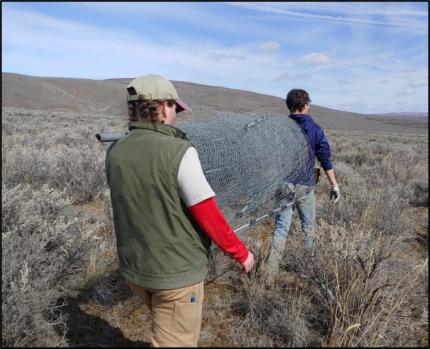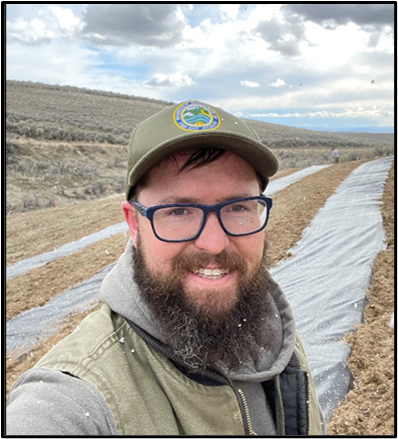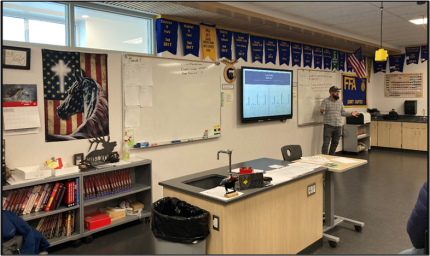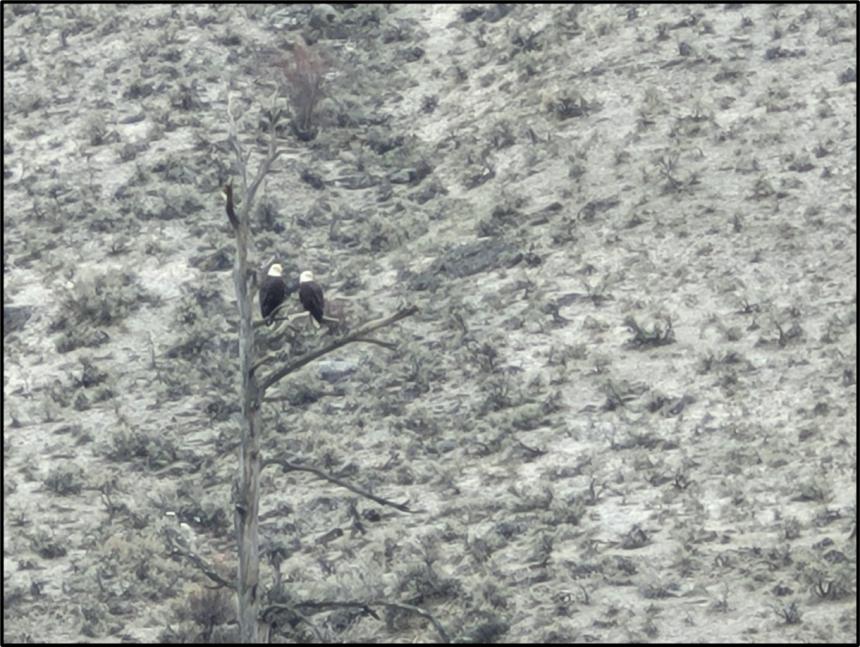Managing Wildlife Populations
Lynx Research: Biologist Fitkin and the Home Range Wildlife Research crew wrapped up the first season of captures for this three-year project. All told, three adult lynx (two males and one female) were fitted with radio-collars. The fourth and final animal captured (a subadult male) was still too light to carry a collar, but he was fitted with an ear tag and will hopefully become a radioed study animal next year. The primary objective of this multi-year project is to see how lynx are using the fire-impacted landscape across a gradient of fire scars of different ages. Results will inform forest and fire management strategies which will help maintain adequate lynx habitat in the face of growing wildlife risk. More information on this project and the locally grown Home Range organization can be found on their website.




Mule Deer Monitoring: Biologists Fitkin and Heinlen began spring mule deer surveys. They have also been following up on mortalities and dropped collars from current study animals with the help of Volunteers Fisher and Rohrer. Spring is coming slowly to District 6 and early data collection suggests fawn to adult ratios are lower than average, although several surveys are still pending.

Mule Deer: Biologist Eilers responded to a mortality signal from one of the GPS-collared mule deer in the Number 2 Canyon area of the Wenatchee foothills. This doe was collared as an adult in January 2022. Upon arriving onsite, Biologist Eilers was quickly able to determine that she had been killed by a cougar. Eilers retrieved the collar for future refurbishment and redeployment elsewhere and collected a tooth sample to determine her age at death.




Wolf Monitoring: Biologist Jeffreys joined Wolf Biologist Roussin on a backpacking trip on the Lake Shore Trail of Lake Chelan to retrieve trail cameras and look for evidence of a wolf pack inhabiting the area. WDFW biologists and North Cascades National Park have received numerous reports of wolves in the Stehekin area over the past couple of years. In the winter of 2020 and 2021, park staff captured images of two adult wolves and four yearlings via trail cameras in the eastern portion of North Cascades National Park suggesting the presence of up to six wolves.
Biologists Jeffreys and Roussin took the ferry to Prince Creek and hiked from there to Stehekin. They meandered up side trails along the way in search of wolf tracks and scat. They also retrieved two cameras placed near Prince Creek earlier this winter, but no photos of wolves were captured. This area represents great mule deer winter range and the biologists observed many deer as well as tracks of elk, moose, and mountain goat. However, over the course of the three-day trip and over 20 miles of trails hiked, biologists only found tracks belonging to a single wolf. That means the most that can be said of this area for now is that it’s a lone wolf territory. The biologists plan to search other trail systems in the North Shore and Stehekin areas in the future to determine if there is indeed a wolf pack there.


Sharp-tailed Grouse: Staff members surveyed the riparian areas around Scotch Creek for sharp-tail grouse. One sharp-tailed grouse was observed foraging in the water birch.
Sage Grouse Surveys: Private Lands Biologist Braaten began grouse count surveys but found very few due to lack of access as many roads are still blocked with snow. Temperatures are warming and snow is melting so we hope to be on the leks very soon. Many roads are just now opening up and providing access. Sage grouse are attending most leks.
Biologist Eilers scouted road accessibility to reach some of the Douglas County sage-grouse leks. Many of the roads are still inaccessible due to snow and muddy conditions but Biologists Jeffreys and Eilers were able to complete their first lek count for the 2023 survey year in the Badger Mountain area. In recent years, this lek has consistently been the most well-attended with up to 30 males displaying on some mornings. It’s off to a good start this year with a count of 25 males and two females.



North American Lagomorph Working Group: A new cooperative lagomorph working group, comprised of representatives from state agencies, tribal agencies, federal agencies, universities, and non-government organizations has been formed. The cooperative working group will identify conservation and management priorities for North American lagomorph species. They will increase cross-state communication, collaboration, and consistency in monitoring. They will also facilitate disease monitoring and management coordination. At the latest meeting, Biologist Gallie presented “Breeding like rabbits: a 20-year history of captive breeding and reintroduction efforts.” Gallie spread awareness of the challenges that have faced the pygmy rabbit recovery project throughout the years and the solutions that have been created in the face of those challenges.
Building Release Pens: The 2022–2023 Rimrock Meadow release pens have been torn down and relocated with the help of the Washington Conservation Corp. Approximately one acre in size, these pens are designed for the soft release of enclosure-born pygmy rabbits. The pens slow the dispersal of pygmy rabbits and help increase survivorship. With the new pens all set up, the pygmy team is looking forward to kit season. It’s just one month away!
New Release Sites: The Black Rock Coulee area has dense intact sagebrush stands that are perfect pygmy rabbit habitat. Meetings with the Bureau of Reclamation have begun so that future controlled burns will avoid burning mature sagebrush critical for pygmy rabbit reintroduction efforts.
Providing Recreation Opportunities
Hunter Access Program: Biologist Morris continued working on updating hunter access contracts so that there are no issues. Morris also checked signs on several properties and replaced signs that were broken or defaced.
Recreation & Partnerships: The Methow Wildlife Area is partnering with Western Washington University to host an intern who’s interested in conservation as well as recreation. It’s anticipated that this intern will assist with a wide variety of land management tasks, including intensive surveys of recreational infrastructure that exist on the wildlife area.
Additionally, Methow Wildlife Area staff members connected the project lead for the Methow Valley Trails Collaborative (MVTC) with WDFW recreation staff. The goal is to initiate a contract with MVTC to assist local wildlife area personnel with surveying trails to identify their maintenance needs. This information will eventually be rolled into a cultural resource survey so future maintenance and upkeep can occur.
Lastly, the MVTC has offered the resources of a National Civilian Community crew to assist with a local Methow Wildlife Area project or two this spring. It’s likely this crew will aid Methow Wildlife Area staff members in combatting erosion issues at Lewis Butte and possibly assist with the installation of a buck and rail fence near a stream that parallels a popular camping area.
Providing Conflict Prevention and Education
America the Beautiful Challenge: Okanogan Lands Operations Manager Haug worked with Okanogan Land Trust Executive Director Miller and various WDFW staff members regarding the development of a proposal for the America the Beautiful Challenge grant offered by the National Fish and Wildlife Foundation. Potential grant funding could include additional support for species mobility, habitat conservation, and restoration funding in the Okanogan area.
Cooperative Burn: Department of Natural Resource staff members and wildlife area personnel along with WDFW Prescribe Burn Program Lead Eberlein met and did a walk-through tour of the planned prescribe burn area for this spring. The prescribed burn will finish up the remaining units of the burn that was treated last year. The prescribed burn units include both Department of Natural Resource and WDFW lands within the Sinlahekin Unit.
Forest Thinning: Scotch Creek staff members and the North Central Washington burn team resumed thinning the forested portions of the Similkameen-Chopaka Unit. The goals of the thinning are to restore historical stand densities, and reduce conifer encroachment into Cottonwood galleries, Aspen groves, and shrubsteppe habitats and to rearrange fuels closer to the forest floor. The thinning will prep the forest for a future prescribed burn.

Habitat Management: Assistant Manager Riley created a proposal for the 2023-2025 Waterfowl and Migratory Game Bird Habitat Project grant through the Migratory Waterfowl and Wetlands Conservation Program. We hope that if we receive this grant, it will help treat invasive tree species (Siberian Elm and Russian Olive) and other weed species on the Driscoll and Eyhott Islands units to improve riparian habitat for waterfowl.
Salmon Restoration: Lands Operations Manager Haug had several conversations and meetings regarding multiple salmon restoration projects within the Methow Wildlife Area. The projects are in various stages of development, have aspects that pose challenges to land management staff, and raise concerns with both the Habitat and Fish programs. WDFW personnel are working closely with one another to provide input to the project proponent so they can address these concerns and move forward with the restoration work.
Wildlife Conflict Bootcamp: Wildlife Conflicts Specialists Bridges and Heilhecker with Supervisor Rickel attended the three-day Wildlife Conflict Bootcamp workshop that focused on implementing Human-Carnivore Interaction Response Training.


Conserving Natural Landscapes
Habitat Plots: Biologists Morris and Cook met with a landowner that is interested in habitat restoration efforts on their land. Options for potential habitat projects were discussed and how WDFW could help with the projects was explained. Standby for next steps.
Biologists prepped a few supplemental food plots near Royal City by mowing vegetation growth from last year. Further plot preparation is still needed, which will include herbicide application and seeding. These plots have sandy soils so Cook will add wood chips, from trees removed from the Region 2 office, to increase organic matter and hopefully build the soil.
In addition, biologists planted a wildlife habitat plot in a circle corner.
Cook broadcast native seed via a broad-cast spreader mounted on an all-terrain vehicle and a drag. Morris followed behind and harrowed to incorporate the seed into the soil. This planting was delayed from last fall due to snow. This plot should provide quality permanent nesting cover for upland birds when it is established.





Oroville High School Field Day: Staff members joined Oroville High Schools Greenhouse Management Teacher Vanderwal and four of her students collecting willow stakes and cuttings on the Scotch Creek Unit. The cuttings and stakes were transported back to the high school greenhouse for further processing. When processing is completed, the students will use the cuttings and stakes on a riparian restoration project along Tonasket Creek on the Charles and Mary Eder Unit.
Douglas County State Acres for Wildlife Enhancement Conservation Reserve Program Update: Private Lands Biologist Braaten coordinated with staff on Natural Resources Conservation Service (NRCS) planning and contribution agreement issues. There is continuous dialogue with upper management about what WDFW has received out of the agreement. The lack of assistance and support by Farm Service Agency and NRCS continues to be an issue and significantly impacts the ability for WDFW to complete their portion of the work.

Providing Education and Outreach
Education in the Classroom: Biologists Morris and Cook and a Pheasants Forever biologist met with nine seniors from Othello High School that wanted to learn more about working for WDFW and what it takes to have a career as a wildlife biologist. Morris and Cook talked to them about education requirements, and the pros and cons of the job. They also spent time outside observing and discussing wildlife and their habitats.


Morris and Cook gave a presentation to the Quincy High School Agricultural Biology class on how WDFW tracks wildlife population changes and why those changes occur.
Conducting Business Operations and Policy
Acquisitions and Easements: Private Lands Biologist Braaten provided information for acquisition discussions and consideration. He also met with a landowner interested in selling some of his land to WDFW.
Agricultural Leases: Lands Operations Manager Haug met with Stewardship Section Manager Walls and Range Specialist Burnham to discuss a Methow Wildlife Area agriculture lease renewal and various other agricultural leases. This began the discussion on determining future rates to each lessee. More work to come this year on the subject.
Agriculture and Grazing: Methow Wildlife Area staff members hosted their first Coordinated Resource Management (CRM) planning meeting of the season. These meetings are coordinated primarily by the permittees and the Okanogan Conservation District. Other attendees typically include representatives from the United States Forest Service, Department of Natural Resources, State Parks, and Bureau of Land Management. Like many of our local grazing permits, a primary goal of this specific permit in the Methow Unit is to benefit habitat for migrating and wintering mule deer. Managed cattle grazing on the approved scale, with comparable stocking rates, and prescriptions should promote or maintain the growth of woody forage used by mule deer.
The Methow Wildlife Area is also working towards the renewal of an agricultural lease near Pipestone Canyon in the Methow Unit. This irrigated lease has three high efficiency, center pivots installed. The goal of this lease is to provide food and cover for wildlife, to provide sharecropping opportunities for the public that are consistent with fish and wildlife objectives, and to make beneficial use of the water rights. Specific wildlife benefits include food and cover for migratory mule deer and forage for upland birds, waterfowl, and black bear to name a few. The crops grown on this lease will provide a high quality, varietal supplement to natural forage sources, particularly going into winter.
Additionally, in the next few weeks, the Methow Wildlife Area hopes to advertise a bid for an irrigated agricultural lease at the Big Valley. One of the primary goals for this lease will be to benefit sandhill cranes that tend to nest in a nearby wetland and are known to use this field for forage and cover with their juveniles. This lease would benefit various other wildlife such white-tailed deer, turkeys, and waterfowl.
District Team Meeting: North Lands Operations Manager Haug led this quarter’s district team meeting. The meeting included two guest presentations by CAPE Communications Outreach Specialists Eckenrod and Desautels who provided an overview of Habitat at Home and some of the science curriculum being developed by the new division. Participants then provided updates from their work units and the group fielded several questions.
Eder Tower: Lands Operations Manager Haug, Scotch Creek Wildlife Area Dupont, and Properties and Acquisitions Specialist Huynh met with a representative of the Okanogan County Sherriff’s Office to discuss the possibility of deploying a communications tower on the Charles and Mary Eder Unit. Staff members asked for additional information and provided the official with an idea of what the request would take in terms of time and effort. The placement may be approximately two to three years out according to their representative and depends on whether or not their request is funded.
Landowner Permitting Database: Specialist Heilhecker participated in a subcommittee meeting regarding the new database for issuing landowner permits. The database they tested last month does not meet the needs of the Wildlife Conflict Program. Therefore, Information Technology is looking at options
Maintenance: Sinlahekin staff members continued to prepare equipment for the upcoming field season. Natural Resource Specialist White has been fabricating axles and hydraulic lift for the harrow seeder that will be used to seed native grass seed on some shrubsteppe restoration sites on the Chiliwist Unit. Staff members will continue with other maintenance activities. They also started annual maintenance of the access site parking lots through the various units of the wildlife area. This treatment will help prevent noxious weeds from growing in the parking lots and help to minimize potential fire hazards.
Maintenance: WDFW personnel removed a large inline irrigation filter from one of the center pivot bases. The filter was starting to rust out from years of use. The filter is no longer needed because the water supplying the pivot is pumped from a well and sediment is no longer an issue. The pivot was replumbed from the mainline.
Meetings: Specialist Heilhecker and Private Lands Biologist Braaten and Supervisor Rickel participated in the Okanogan District team meeting.
R2N Virtual Tour: Lands Manager Haug presented to the Lands Division quarterly meeting a virtual tour of wildlife areas and water access areas in Okanogan County. The presentation mainly discussed wildlife and water access areas and touched on successes and challenges. The virtual tours will hopefully become a standard segment of each meeting.
Sealing: Private Lands Biologist Braaten sealed two bobcats and a river otter. Information was downloaded to Convention on International Trade in Endangered Species (CITES) application.
Training: Most of the Region 2 north lands personnel participated in an annual Wildland Firefighter Refresher Course (RT-130). This course is mandatory for staff members to maintain their red card certification for wildland firefighting and prescribed burning. The course was taught by Burn Specialist Eberlein of the WDFW Prescribe Burn Program.
Sinlahekin and Scotch Creek staff members participated in an annual pesticide recertification class. These classes are needed to maintain their certification and licenses so that they can continue to use herbicides to control noxious weeds on the wildlife area.
Wolf Advisory Group Meeting Preparation: Specialist Heilhecker participated in a Wolf Advisory Group (WAG) coordination call to plan the April WAG meeting. The WAG is a citizens’ committee that advises wolf policy related issues.
Pivot Clean Up: In 2020 a windstorm blew over the south pivot on the Chopaka Unit. The severely damaged pivot was dismantled and stacked in the corner of the field, spring of 2020.
This week staff members removed all the tires, gear box, center drives, drive lines, and hauled them to the Eder Unit for storage and reuse.
The remaining large pieces of metal and pipe will be picked up by the WDFW construction shop later this spring for recycling.


Deck Repair: Scotch Creek staff members replaced all four posts that were supporting the awning covering the back porch of the office. The old posts were starting to deteriorate and compromising the integrity of the awning. Staff members also replaced the deck boards and cover to the domestic well.

Other
Migrating Waterfowl: Snow geese and other waterfowl can be seen and heard almost daily flying over Ephrata on their migration north. It’s a good sign spring is on the way.


Hiring of Natural Resource Technician: The advertisement for two natural resource technician positions closed, and six candidates were forwarded for consideration. Application material for each candidate was evaluated by staff members and interviews were scheduled. These two positions will assist with the increasing workload associated with Farm Bill support as well as increasing maintenance needs for habitat plots installed by private lands biologists.
New Technician: District 7 biologists just welcomed a new biological technician onto their team for the 2023 summer season. Sophia Hara will be assisting in greater sage-grouse and sharp-tailed grouse lek counts and lek surveys as well as upcoming Washington ground squirrel surveys.
With additional help private lands biologists expect to install added habitat and maintain Hunter Access property signs more efficiently each year.

Weather Conditions: What a difference a day can make! The snow was slowly leaving the Sinlahekin Wildlife Area and its units. Most of the south facing slopes were baring up, then we received approximately four new inches of snow within 24 hours. Temperatures have still been hovering around freezing with a few days of highs in the low 40s, but mostly sunny. The few days of above freezing temps have allowed staff members to get out and do some field work prep for this coming spring, which they are anxiously waiting for.








